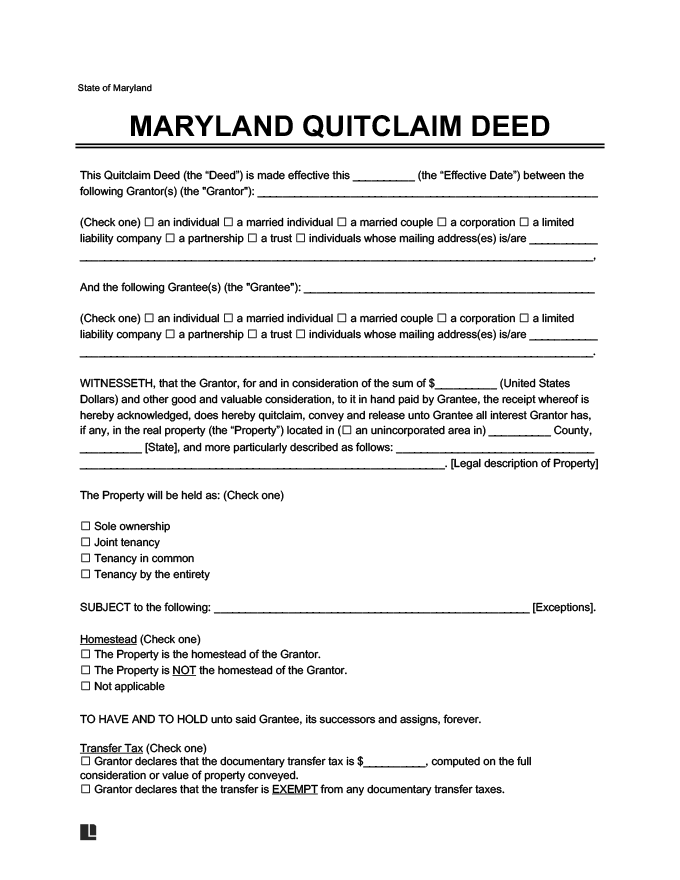In Maryland, quitclaim deeds allow for the faster and easier transfer of property between two people or entities when compared to other deed options. To properly fill out and file a quitclaim deed in Maryland, preparers must include the correct information and documents, sign the deed properly, and pay any filing fees or taxes.
Legal Framework
Maryland quitclaim deed requirements are covered in Maryland Code (MDC) Real Property (Prop.) Tit. 3 – Recordation. Other relevant sections exist throughout both the Real Property and Tax – Property articles of the Maryland Code.
Legal Description
The legal description of a property transferred by a Maryland quitclaim deed should include:
- The property’s county
- Its address
- Its plot number
- A description matching the one on the most recent deed, containing unique identifiers
Signing
According to MDC Real Prop. § 4-101, signature requirements for quitclaim deeds completed in Maryland include:
- The grantor, or giver of the property, must sign the document in front of a notary public
- The grantee, or receiver of the property, does not need to sign the document
Terminology
Unlike other states, no state-specific language requirements exist in Maryland for quitclaim deeds.
Additional Documents
To submit a quitclaim deed to the clerk of the circuit court, you must first complete a land instrument intake sheet to determine transfer and recordation tax, if any.
Filing
Per MDC Real Prop. § 3-104, you must file Maryland quitclaim deeds with the clerk of the circuit court in the property’s county. Each county has recording fees, and some require a municipal lien release fee.
Validity Requirements
In order to be accepted by the clerk of the circuit court in the county where the property resides, a Maryland quitclaim deed must:
- Identify the property properly — by county, address, plot number, and legal description
- Contain the grantor’s official signature, completed in front of a notary public
- Have a completed land instrument intake sheet attached
Content Requirements
The content portion of a quitclaim deed for Maryland must additionally contain the following information:
- The preparer’s details, whether this is the grantor or the attorney
- Where to send the document after it has been filed (usually to the grantee)
- The grantor’s details, including name and address
- The grantee’s details, including name and address
- How much money, if any, will be exchanged during the transfer
- Signature of the preparer, identifying them as either grantor or attorney (not needed to be completed in front of a notary)
Quitclaim Deeds vs. Other Property Transfer Methods
| Quitclaim Deed | A quitclaim deed is a reliable method for easily transferring property between people who know each other, like family members, in non-complex situations. It offers no protection against title defects, so it should not be employed between two parties who do not know or trust one another or in more complex property transfer situations. |
| Grant Deed | A grant deed is employed to offer more protection against title issues than a quitclaim, but less than a warranty deed. It guards against the grantor having already transferred the property to a party outside of the grantee. It also provides guarantees against the possibility that the grantor burdened the property with any debts or legal claims. |
| Warranty Deed | A general warranty deed provides the greatest protection to the grantee of all available deed options, while a specialty warranty deed provides a medium level of protection. The general warranty guards against any title defects during the entirety of the title's existence by any previous owners, while the specialty warranty guards against any defects imposed by the grantor. |
| Title Insurance | A grantee can purchase a title insurance policy, either directly from the grantor or from a Maryland title insurance company, in order to protect themselves from title defaults not guarded against in the deed. This is a useful supplement to a quitclaim deed in order to better protect the grantee's interests. |
| Estate Planning Deeds | In Maryland, transfer on death deeds, or TODDs, are permissible. By filling out a TODD in Maryland, a person who is elderly or ill can protect their right to own and use their property until death, while also recording who their property should go to when they die. Essentially, it deeds the property to the chosen person or entity as soon as the grantor passes away. |
| Co-Ownership | Maryland co-ownership laws allow for three different situations of real property co-ownership: (1) tenancy in common, (2) joint tenancy, and (3) tenancy by the entirety. Joint tenants, often spouses or a parent and child, hold an undivided interest in the property. Tenants in common each own a share of the property, with no right to survivorship. Tenants by entirety are spouses that each own an undivided interest in the property with no right to survivorship. |
